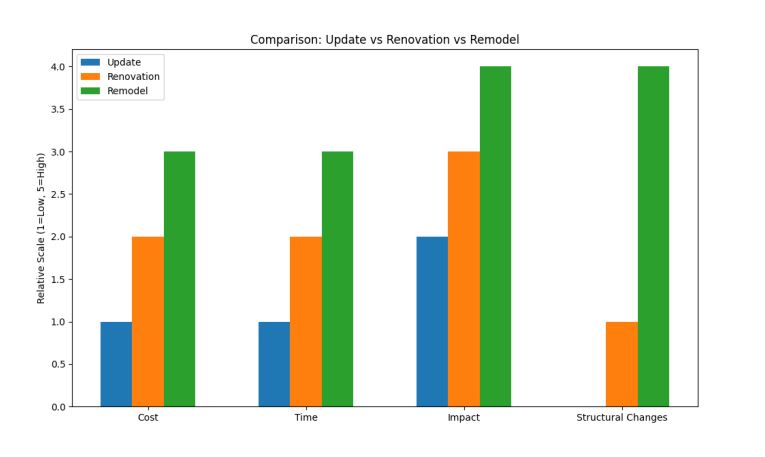🛠 Renovation vs. Remodel vs. Update: What’s the Difference?
These words are often used interchangeably, renovation and remodeling have distinct meanings. Remodeling involves significant changes to the purpose and layout of a space, while renovation focuses on repairing and improving the existing structure. For example, converting a bedroom into a bathroom is a remodel, while updating the fixtures and finishes in an existing bathroom is a renovation.
-
Renovation
- Definition: Restoring or updating an existing space without changing its structure.
- Examples: Repainting walls, replacing flooring, updating cabinets or fixtures.
- Goal: Refresh and modernize while keeping the original layout intact.
- Cost: Generally less expensive than remodeling.
- Ideal For: Cosmetic upgrades, rental property improvements, or prepping a home for sale.
-
-
Reasons for Renovations:
-
-
-
- Increased functionality and comfort:Making spaces more usable and enjoyable.
- Enhanced aesthetics and style:Updating the look and feel of a space to reflect personal preferences.
- Increased property value:Adding features that appeal to potential buyers and increase the home’s market value.
- Addressing wear and tear:Repairing damaged or outdated features.
- Energy efficiency improvements:Upgrading to more efficient appliances and insulation.
- Adapting to changing needs:Making spaces more suitable for growing families or changing lifestyles.
- Increased functionality and comfort:Making spaces more usable and enjoyable.
-
-
Remodel
- Definition: Changing the structure, layout, or purpose of a space.
- Examples: Removing walls to create an open floor plan, converting a garage into a living space, or adding a bathroom.
- Goal: Transform how a space functions.
- Cost: Typically more expensive due to structural changes and permits.
- Ideal For: Long-term value increases, custom living needs, or major property repositioning.
-
Update
-
- Definition: Making small, often cosmetic changes to modernize a space.
- Focus: Quick improvements that enhance style or function.
- Examples:
- Swapping out light fixtures
- Changing cabinet hardware
- Adding smart home features
- Goal: Keeping the space current without major work or expense.
Which One Should You Choose when Investing Or Retiring?
- Investors:
- Updates are great for quick value boosts before listing or renting.
- Renovations can increase appeal and rental income.
- Remodels may be worth it for flipping or repositioning a property.
- Retirees:
- Updates and renovations help maintain comfort and style.
- Remodels can adapt a home for aging in place (e.g., wider doorways, walk-in showers).
Here’s a guide to help you decide when to choose renovation, remodel, or update, depending on your goals, budget, and property type:
🏡 When to Choose Renovation, Remodel, or Update
✅ Choose an Update When:
- You want quick, low-cost improvements.
- The goal is to refresh the look without major work.
- You’re preparing a home for sale or rent and want to boost appeal.
- Examples:
- Swapping outdated light fixtures
- Replacing cabinet hardware
- Adding a smart thermostat
Best for: Budget-conscious investors, staging for resale, or modernizing a rental unit.
🔨 Choose a Renovation When:
- The layout works, but the space feels worn or outdated.
- You want to increase property value without major structural changes.
- You’re improving functionality and aesthetics.
- Examples:
- Replacing flooring or countertops
- Updating bathrooms or kitchens
- Repairing drywall or repainting
Best for: Mid-range upgrades, long-term rentals, or refreshing a home for retirement.
🏗️ Choose a Remodel When:
- You need to change how a space functions.
- You’re dealing with structural issues or want to reconfigure the layout.
- You’re planning a major transformation (e.g., open concept, additions).
- Examples:
- Converting a garage into a living space
- Expanding a kitchen or adding a bathroom
- Creating an in-law suite or rental unit
Best for: Flipping homes, adapting for aging in place, or maximizing ROI in high-value markets.

NOTE: When planning above, please keep in mind what permits are required by your city/town in your state.
🏗️ Remodeling Permits in Massachusetts: What You Need to Know
🔍 When Are Permits Required?
In Massachusetts, most remodeling projects require permits, especially if they involve:
- Structural changes (e.g., removing or adding walls)
- Electrical work
- Plumbing work
- HVAC installations
- Additions or expansions
- Window or door replacements (if altering size or structure)
Even if you the home owner are doing the work yourself, you must apply for the permit through your local building department. If you hire a contractor, they are responsible for obtaining the necessary permits.
🧾 Types of Permits
- Building Permit
Required for structural changes, additions, and major renovations. - Electrical Permit
Must be obtained by a licensed electrician for any electrical work beyond minor repairs. - Plumbing Permit
Required for new installations or major plumbing changes. Only licensed plumbers can apply. - Mechanical Permit
Needed for HVAC system installations or modifications.
🏛️ Where to Apply
Permits are issued by your local municipal building department. Many towns offer online applications for minor work, but larger projects may require in-person submission with detailed building plans.
⚠️ Why Permits Matter
- Legal Compliance: Avoid fines and project shutdowns.
- Safety: Ensures work meets building codes.
- Resale Value: Unpermitted work can complicate future sales or refinancing.
- Insurance: Claims may be denied if work was done without proper permits.
🛑 What Doesn’t Require a Permit?
Minor repairs like:
- Painting
- Replacing fixtures (without altering plumbing/electrical)
- Flooring updates
Always check with your local building inspector to confirm.
The timeline for obtaining remodeling permits in Massachusetts can vary depending on the scope of the project, municipality, and completeness of your application, Fro reference, here is a general breakdown to help you get started.
🗓️ Typical Permit Timeline for Remodeling in Massachusetts
1. Preparation (1–2 weeks)
- Design & Planning: Finalize your remodeling plans with an architect or contractor.
- Documentation: Gather required documents like site plans, construction drawings, and contractor licenses.
2. Application Submission (1–3 days)
- Submit your permit application to your local building department (online or in person).
- Some towns offer short-form permits for minor work, which can be processed faster.
3. Review Process (1–4 weeks)
- The building department reviews your plans for code compliance.
- Simple renovations (e.g., interior updates) may be approved in a few days.
- Complex remodels (e.g., structural changes, additions) may take several weeks, especially if multiple departments (zoning, fire, health) are involved.
4. Permit Issuance
- Once approved, you’ll receive your permit and can begin work.
- You may need to schedule inspections at various stages of the project.
⏱️ Fast-Track Tips
- Hire a licensed contractor: They often know how to navigate local processes efficiently.
- Submit complete and accurate plans: Incomplete applications are the #1 cause of delays.
- Check local timelines: Each city or town in Massachusetts may have different processing speeds.

 Facebook
Facebook
 X
X
 Pinterest
Pinterest
 Copy Link
Copy Link


